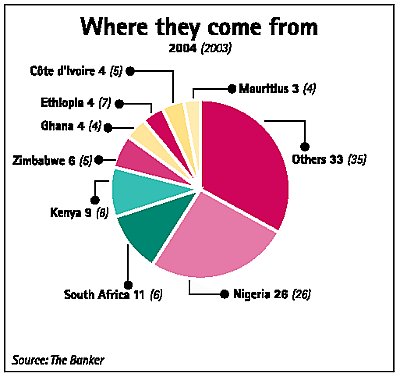The Banker’s Top 100 ranking of African banks shows an upward trend in Tier 1 capital and assets and profits for the region.
The top positions in this year’s listing of the Top 100 sub-Saharan African banks are again occupied by the ‘big five’ South African banks who are joined in the listing by African Bank at six, Capitec Bank (27), Teba Bank (35), Sasfin Bank (50), Rennies Bank (59) and Mercantile Lisbon (78). Together the South African banks account for 73.9% of the total Tier 1 capital of the Top 100, 83.2% of the total assets and 69.3% of the total pre-tax profit.
The increase in the number of South African banks represented in the Top 100 has come about largely through an unbundling of banking activities from both financial and non-financial industrial groupings.
The overall total Tier 1 capital of the Top 100 rose by 34.3% to $17.6bn, combined total assets rose by 41.9% to $303.9bn and combined pre-tax profit grew 42.4% to $5.3bn. Of the banks in the Top 100, 27 are owned by banks from outside of the region. The current negotiations between Barclays Bank and ABSA – in which the former is seeking to acquire the South African bank – may, if successful, result in a future realignment of the reporting line for Barclays’ other African holdings.
Beyond South Africa
Nigeria, again, provides the largest block of banks in the listing with 26, led by First Bank of Nigeria (seven) and Union Bank of Nigeria (eight) followed by Zenith International Bank at 14, but only accounts for 9.0% of the aggregate Tier 1 capital, 5.3% of aggregate assets and 10.6% of aggregate pre-tax profits. The banking sector in Nigeria remains weak and fragmented with significant scope for consolidation. The incoming governor of the Central Bank of Nigeria, Charles Soludo, has announced a package of measures including raising the minimum capital requirement from N1bn ($7.5m) to N25bn, with compliance required by the end of 2005. The aim is to force consolidation among the 89 banks currently licensed. At the end of the first quarter 2004, 14 of these were classified as marginal and 11 as unsound; between them these banks accounted for 19.2% of the total banking assets.
Following on from Nigeria in terms of share of the total Tier 1 capital are the 33 banks encapsulated in Others, which account for 6.2% followed by Zimbabwe (six banks) with 2.8% of the total and Mauritius whose three banks account for 2.6%.
The Zimbabwean banks’ figures continue to reflect the use of inflationary accounting as the economy continues to deteriorate, with the consumer price index for 2003 running at 598.7%. The Mauritian banks are led by Mauritius Commercial Bank (nine) and State Bank of Mauritius (11), both of whom increased their capital. The nine banks from Kenya contribute 2.3% of the total Tier 1 capital.
Non-performing loans still remain the problem throughout the region as can be seen from the country listing, where NPL figures, from the 43 banks which disclosed them, range from 0.05% to 43.3%, with an average level of 11.86%.



